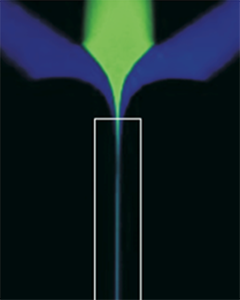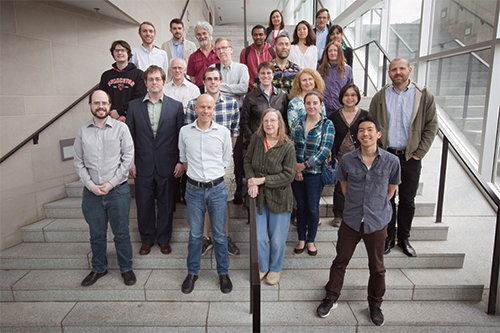X-RAY RUNS: Apply for Beamtime
2017 Nov 1 - Dec 21
2018 Feb 7 - Apr 3
2018 Proposal/BTR deadline: 12/1/17
2018 Apr 11 - Jun 4
2018 Proposal/BTR deadline: 2/1/18

Six summer science workshops at CHESS followed a most memorable Users’ Meeting on June 7th when our user community first heard the big news about plans to reconfigure the accelerator and beamlines to use only a single source of particles. This will involve relocating the five experimental stations on the A, B, C, and D beamlines, and upgrading the replacement stations with independently tunable high-flux undulator sources. The goal of the workshops was to identify pressing and important scientific needs for a future high-energy x-ray source utilizing unique capabilities of the Cornell accelerator and special types of organization and user support.
This “biomolecules” workshop was held on June 8th and involved 11 invited speakers and 36 attendees. 19 remote viewers asked questions and participated in discussions through the on-line YouTube stream. The local organizing committee consisted of Richard Gillilan and Marian Szebenyi (MacCHESS) and Nozomi Ando (Princeton). This workshop focuses on motion of biomolecules (proteins, nucleic acids, complexes) which occurs as they perform their functions. “Motion” includes conformational changes, ranging from large domain “hinging” motions to relatively small loop motions (e.g. to allow and deny access to an active site); oligomerization changes; interaction with partner molecules.
The full agenda for the workshop with speakers’ names and presentation titles and abstracts are available online here: http://meetings.chess.cornell.edu/sciworkshops2016/Workshop2.html
Lee Makowski (Northeastern University) introduced first the topic that protein function depends on motion and that motion is a lot more complex than static structures. Measurements on many time and length scales will be needed, along with a strong computational framework, to understand this difficult topic. Solution small- and wide-angle scattering, time-resolved crystallography, microfluidic mixers, laser and thermal pumping systems synchronized to the storage-ring x-ray pulses, are all parts of the experimental arsenal needed to make striking new discoveries in biomolecular systems in fields as diverse as plants, animals and human disease and health.
During the workshop it grew common to discuss biomolecules as “molecular machines.” In order to understand how molecular machines work, it is necessary to look at their dynamics, i.e. how the parts move and interact when the "machine" is working. Static structures, from crystallography or cryoEM, provide snapshots which are useful in deducing how biomolecules might function, but more dynamic measurements are necessary to determine what actually happens during their operation. Workshop attendees discussed how the most promising methods for obtaining dynamic information include time-resolved SAXS/WAXS (small-angle/wide-angle X-ray scattering from solution), time-resolved serial crystallography using a large number of small crystals, and diffuse scattering from crystals. The use of anomalous scattering, obtained through measurements at multiple wavelengths, can be applied to SAXS/WAXS and diffuse scattering experiments to provide more complete information than we can get from single-wavelength experiments.
An upgraded CHESS will be a great place to pursue study of dynamics because (1) it will provide the high-flux, tightly focused beams necessary to work with small samples utilizing short exposure times and (2) the CHESS source could be configured to provide x-ray pulses with large numbers of photons and separated in time and (3) the variety of different experiments proposed fits well with the demonstrated flexibility of CHESS stations and staff.
After the meeting, CHESS scientists, organizers and participants joined forces to summarize notes and compose “white papers,” capturing the scientific need and opportunities for innovative work using an upgraded CHESS source. CHESS scientists are now working with members of the CHESS External Advisory Committee and members of the CHESS Users’ Executive Committee to refine, combine, reduce and/or sharpen the ideas captured from the workshops. The CHESS staff is enormously grateful to members of the user community and beyond who’ve helped shape the future of CHESS.
Stay tuned to the CHESS eNewsletter to hear exciting updates on the CHESS-U upgrade.

Some of the participants at Workshop 2 in the Physical Sciences Building.
Submitted by:
Ernest Fontes and Rick Ryan, CHESS, Cornell University
07/13/2016
